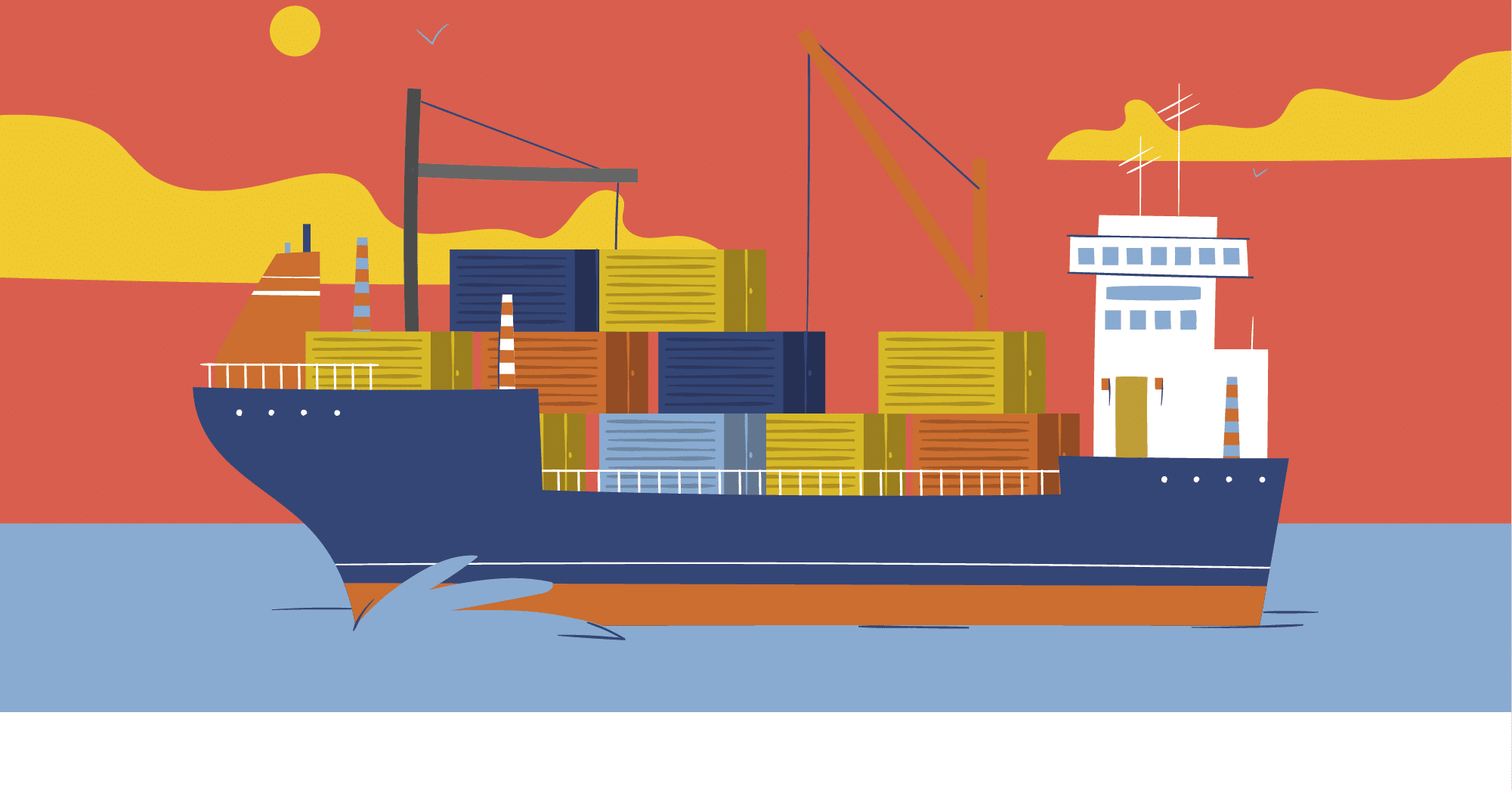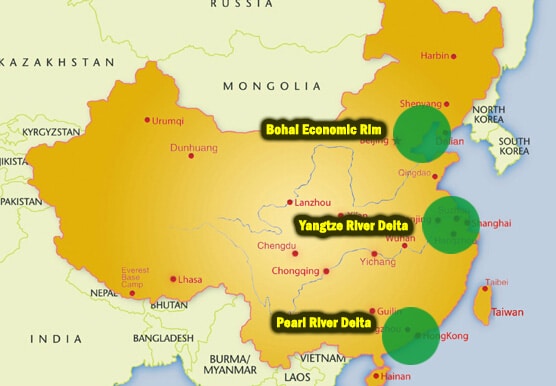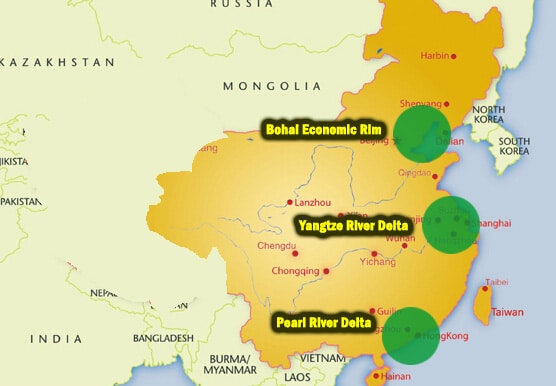The Three Golden Importing Regions of China

Here's a tidbit you might not have known: China is a big country with a lot of people!
OK, you probably knew that. But even for the biggest China geography nerd, the numbers are still staggering. China has over 1 billion people. So when researching a Supplier and trying to figure out where exactly your Supplier's city is, it can be overwhelming. Where exactly is Hangzhou and what exactly is a Zheijang province?!
Thankfully, for importers, China can more or less be broken down into three regions: The Pearl River Delta, The Yangtze River Delta, and the Bohai Rim Economic Circle. The chances are extremely good that your Suppliers are located in one of these three regions. By understanding these three major regions in China you will be able to conceptualize the location of your Suppliers more easily and in turn use this knowledge to help you better choose Suppliers and maintain great relationships with them.
Geography
These three regions of China are all located along the East Coast of China, which makes sense as these industrial export hubs need ports to ship the goods out. The three regions can be broken out into a Northern Region (Bohai Rim Economic Circle), Middle Region (Yangtze River Delta), and Southern Region (Pearl River Delta).
Each of these regions is home to one of China's three mega cities: Beijing (Bohai Rim Economic Circle), Shanghai (Yangtze River Delta) and Guangzhou (Pearl River Delta). If you're not familiar with all three of these cities, you should be as they're also often used as points of reference when discussing smaller cities, i.e. “Hangzhou is 200 kms from Shanghai“.

Nearly every Supplier I have ever worked with has been located in one of these three regions and the vast majority of the time your Suppliers will be located in one of these regions as well. So while China is a big country geographically and population wise, when you can think of it in terms of these three regions, it becomes much easier to envision.
China is even a smaller country to consider when you exclude the Western provinces of Tibet and Xinjiang. I'm not one to repaint the borders of China, but these two provinces have historically had significant independence movements. For political, cultural, geographical and other reasons, these provinces have not traditionally been a large source of industrial development by most Suppliers in China. For better or worse, you'll be unlikely to ever find a Supplier from one of these two provinces.

Different Regions Specialize in Different Products
In America there tends to be regions which specialize in different industries. For example, Detroit specializes in the automotive industry, Texas is the oil capital of America, and Silicon Valley tends to attract anything tech related. Well, China is the same way, but on steroids. You may find an entire city devoted to undergarments and another one devoted to holiday decorations. It's common occurrence to find out that a particular commodity, like underwear, used by the vast majority of the world often began its life in one city in China (or even one factory).
Subsequently, as you're searching Alibaba or walking through a trade show, you're likely to discover that most of the Suppliers for the product you're looking for are located in the same region and/or city. Shenzhen is one of the most popular examples of this as a huge chunk of China's electronics all originate from this city.
Why it Matters
So why should you bother to even give the geography of China a second of your time? Well, for at least a few reasons:
- Keeping your Suppliers within close proximity to one another can result in reduced freight costs
- Keeping your Suppliers within close proximity to one another makes travel easier
- Sourcing products from Suppliers within hubs for specific products often have better quality products
Whenever you can, it makes sense to keep Suppliers within close proximity to one another. When your Suppliers are geographically close, you can potentially arrange to have shipments combined. If you're shipping half a container of products from a Supplier in Shanghai and half a container of products from a Supplier in Wuxi, you may be able to combine everything into one container, potentially saving you time and money. You could theoretically do the same thing with a Supplier in the Bohai Region and Pearl River Delta region, but the increased domestic freight charges in China would likely reduce any cost savings.
Having Suppliers within close proximity to one another also makes visiting them (something you should do) much easier. I'll frequently hear of first time travelers to China who have a week to visit and want to visit Suppliers in Beijing (Northern) Shanghai (Middle) and Shenzhen (Southern). While this is possible it would be like having a week to visit Seattle, Los Angeles and New York. It'll mean many air plane rides and a new hotel every other night- this is extremely draining! If all of your Suppliers are in the same region, you can stay in one city, use it as your base, and visit your Suppliers as day trips. Better yet, as long as your Suppliers are within a couple of hours of your base city, they'll likely even send a private car to get you and save you the adventure of trying to figure out the Chinese domestic bus and train system.
Finally, as mentioned before, different industries tend to populate specific regions in China. This means if you're researching Suppliers of headphones, for example, and you notice 9 of the 10 Suppliers are all located in the Pearl River Delta region but one of them is located in the Bohai Economic Rim region, the Bohai Supplier is truly an outlier. There tends to be a lot of knowledge trading, vendor sharing, and competition in regions which specialize in particular products. The 9 headphone Suppliers in Shenzhen will be learning from each other and competing with each other. This isn't to say the Bohai Economic Rim Supplier doesn't have great headphones, but for me, I'd prefer to order Shrimp Jumbalaya from Louisiana rather than Minnesota.
Conclusion
It's easy to get intimidated by looking at a map of China and seeing a bunch of indecipherable city names. Fuzhou looks a lot like Fujian and Qingdao is similar to Qinghai. However, by understanding these three golden importing regions, Chinese geography becomes a lot easier to envision.
Have you found that most of your Suppliers come from one of these three regions? Have you ever worked with a Supplier from one of the least popular regions like Tibet or Xinjiang? If so, please comment below.




Every time I’m reading a post in this blog I learn something new :-) Very interesting article.
BTW: Another reason to keep suppliers close is if you want to do product bundling from two different suppliers into a single product.
-Liron
Yes! Absolutely. Offering the shoes and the shoe polish together in the same package is a great differentiating technique.
Great article! Would love a more indepth one per seller category! Thanks a lot!
What you manufacturering